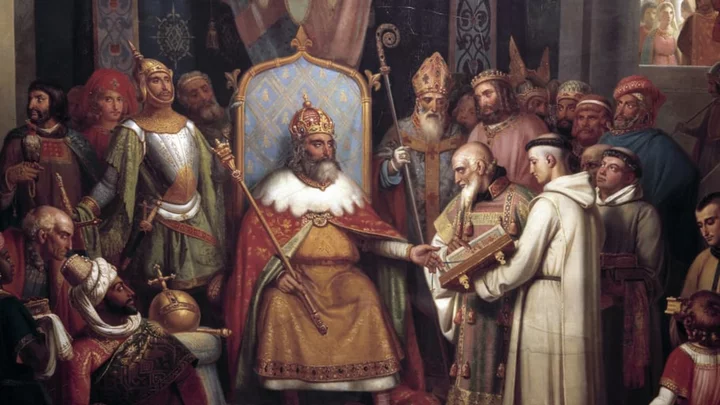Between 768 and 814 CE, Charlemagne—also known as Karl or Charles the Great—ruled an empire that spanned most of Western Europe. After years of relentless warfare, he presided over present-day France, Germany, Belgium, the Netherlands, and other territories. The Carolingian Renaissance (a revival named for the dynasty founded by Charlemagne’s grandfather) rose out of the bloodshed, with an accelerated artistic and literary output that both celebrated antiquity and pushed for a newly standardized Christian culture. Nevertheless, the might of this empire rested on Charlemagne alone, and after his death it quickly fell apart. Here are 13 facts about the first Holy Roman Emperor.
1. His father wasn’t born a king.
Charlemagne’s father, Pepin III—often called Pepin the Short—was mayor of the palace (administrator of the royal court) before he was named the first king of the Franks. After a concerted campaign to become ruler, Pepin finally became king in 751, and three years later was officially anointed by the pope, who at the same time anointed Pepin’s sons Carloman and Charles (the future Charlemagne) with the holy oil that demonstrated their special status. Pepin III served until 768.
2. Charlemagne’s brother died soon after becoming co-king.
After Pepin III died, Charlemagne shared power with his younger brother Carloman, with the two acting as joint kings. It wasn’t a smoothly shared reign, however, as evidenced by a 769 episode in which Carloman seemed to undermine Charlemagne’s authority by refusing to assist in suppressing a revolt in Aquitane. Then, Carloman suddenly died in 771.
Exactly how Carloman perished so conveniently is mysterious. The most common account is that he died of a nosebleed, though what caused it is a matter of debate, with one historian proposing a peptic ulcer as the underlying issue. Whatever the cause, after his death Charlemagne concentrated all of Carloman’s land and power and became the sole king of the Franks.
3. He’s considered the father of Europe.
As the king of the Franks, Charlemagne set out on an ambitious and bloody campaign to expand his territory. By the time of his death in 814, this kingdom included the majority of what is now considered Western, and some of Central, Europe. Not since the Roman Empire had this much of the continent been controlled by one ruler. Because of this (albeit fragile) unification, Charlemagne is sometimes called the father of Europe.
Over the centuries, the name Charlemagne became associated with European unification, whether through peaceful initiatives such as the European Union or war. For instance, Napoleon Bonaparte, who had his own dreams of empire, declared in 1806, “Je suis Charlemagne”—“I am Charlemagne.”
4. Being crowned emperor may have been a surprise to Charlemagne.
Pope Leo III crowned Charlemagne emperor at Christmas mass in 800. Charlemagne had arrived in Rome a few weeks earlier at the request of the pope, but by many accounts, including that of his court scholar Einhard, he was not expecting his new role, and only realized what was happening when the pope put the imperial crown on his head.
Since the crowning was advantageous to both parties, it’s likely there was some partnership behind the event (it’s also possible Einhard may have wanted his friend Charlemagne to appear more humble in his biography). Importantly, the coronation recognized Charlemagne as ruler of a Holy Roman Empire, which carried an associated ambition of outdoing the military and cultural achievements of the pagan Roman Empire. It also served to notify Charlemagne’s enemies that his domination of Western Europe was sanctioned by the church.
5. Religious music flourished during his reign.
Charlemagne loved church music, particularly the liturgical music of Rome. At his request, Pope Hadrian I sent monks from Rome to the court of Aachen to instruct his chapel’s choir in 774. This event helped spark the spread of traditional Gregorian chant through the Frankish churches. In 789, Charlemagne also issued a decree to his empire’s clergy, instructing them to learn (and sing properly) the Cantus Romanus, or Roman chant. Music schools were also founded under Charlemagne’s reign, and monks transcribing music helped preserve the Gregorian chant into the present day.
6. Much of what we know about antiquity is because of Charlemagne.
Charlemagne was a fierce proponent of Christianity, yet he had great respect for the culture of pagan antiquity. He also saw his empire as a direct successor to the glory of the Roman world. The scholars of the Carolingian Renaissance discovered and preserved as much of antiquity as possible, and its survival into the modern day is largely thanks to their efforts. On Frankish campaigns, soldiers would bring back ancient Latin literature alongside other loot. Carolingian monks meticulously copied these old texts into new volumes, helping preserve Cicero, Pliny the Younger, Ovid, and Ammianus Marcellinus. Even after Charlemagne’s reign, these European monasteries remained devoted to the preservation of Latin literature and knowledge.
7. Currency was standardized in his empire.
As Charlemagne conquered Western Europe, he recognized the need for a standard currency. Instead of a variety of different gold coins, his government produced and disseminated silver coinage that could be traded across the empire—the first common currency on the continent since the Roman era. The currency’s system of dividing a Carolingian pound of pure silver into 240 pieces was so successful that France kept a basic version of it until the French Revolution.
8. Charlemagne dressed in common clothes.
Charlemagne was an imposing figure, with a height estimated between 5 feet 10 inches and 6 feet 4 inches, which was quite a bit taller than the average male height at the time. Yet he wasn’t showy in his style. According to Einhard, he dressed in the ordinary clothes of the Frankish people, with a blue cloak over his tunic, linen shirt, and long hose. The one bit of flash he always had was a sword, worn on a belt of gold or silver. To dress up for special occasions, he’d sport a jeweled sword.
He also was not fond of flamboyant dress in the people around him. An anecdotal tale from the 9th-century De Carolo Magno relates how he spent a whole day tormenting some courtiers who returned from a festival decked out in silk and ribbons. He made them go hunting with him without a chance to change their clothes, and immediately upon returning had them attending him into the night. The next morning he ordered them to return, dressed in their wrecked finery, and ridiculed them for demeaning themselves by wearing such impractical clothes.
9. He had many wives and children.
Amid all those years riding around Europe waging war, Charlemagne somehow found time to get married to five different women and have relationships with several concubines. He fathered around 18 children. If there was one soft spot in the emperor’s heart, it was for his kids, as he supported the education of both his sons and daughters. He didn’t allow any of his daughters to get married during his lifetime—not necessarily to protect them from rakes like him, but probably because these marriages would have raised the status of their husbands’ families too much for his comfort.
10. His one major defeat was immortalized in poetry.
Charlemagne’s first campaign to conquer Spain was a disaster, culminating in his only major military defeat. After his army entered the Iberian peninsula in 778, having been promised an alliance by Sulaiman Ibn al-Arabi in Barcelona that could spread Christendom into the Muslim territory, they made quick progress into the south towards Zaragoza. There, things went wrong. The governor, Hussain Ibn al-Ansari, resisted the Franks, and after some negotiation, offered gold in exchange for a Frankish retreat. Charlemagne accepted and left, destroying the defensive walls of Pamplona on the way back so they could not be used as a base for attack against his men.
As they moved through the wooded Roncevaux Pass in the Pyrenees, Charlemagne’s forces were ambushed, mostly by Basques who may have been angered by the wreckage of Pamplona or their ill treatment by Charlemagne’s soldiers. Unfamiliar with the mountainous landscape, the Frankish rear guard was overwhelmed, losing many men, including the prefect of Breton, named Roland. The bold Roland was immortalized and mythologized in the medieval epic poem The Song of Roland, one of the oldest surviving examples of French literature.
11. His name now means “king.”
Charlemagne’s given name (Karl in German) was bestowed by his parents in honor of his grandfather, Charles Martel, and derives from the German for “free man.” While the German kerl is now understood to mean “guy,” variants of the name karl have come to mean “king” in other regions. From the Czech král to the Polish król to the Lithuanian karalius to the Latvian karalis, languages all over Europe have traces of his influence in their word for king. Charlemagne’s notoriety also popularized the name Charles throughout much of Europe, where it remains common today.
12. He ordered a massacre that became Nazi propaganda.
Over three decades, Charlemagne warred against the Saxons in today’s northwest Germany. Most notoriously, in 782 he is said to have ordered the execution of around 4500 Saxons. Under his rule, any members of the pagan Germanic tribe who didn’t convert to Christianity were also put to death.
The massacre gained new historical prominence in the 20th century, after the Nazis built a stone monument in 1935—the Sachsenhain memorial—remembering its victims. Charlemagne was reframed as an enemy of traditional Germanic culture and an example of the evils of the Catholic Church. Some 4500 stones were erected at the site where the Saxons were believed to have been killed. This demonization of Charlemagne was brief, however, and by 1942 the Nazis were celebrating the 1200th anniversary of his birth as a symbol of German superiority. The units of French volunteers who served in the German Schutzstaffel (SS) during World War II were named the Charlemagne Regiment.
13. The empire crumbled after Charlemagne’s death.
Charlemagne died in 814, and his empire didn’t live on much longer. All of the strength of his government radiated from his reputation and the threat of war if he was not obeyed. The Frankish tradition was to divide power equally among male heirs, and although Charlemagne’s only surviving legitimate son was Louis the Pious, he died in 840. The empire was soon separated between Louis’s three sons. These three kingdoms continued to break down until the deposition of Charles III in 887, at which point most of the Carolingian power was gone. Not a century after his death, Charlemagne’s empire was no more.
A version of this story was published in 2018; it has been updated for 2023.
This article was originally published on www.mentalfloss.com as 13 Facts About Charlemagne, the First King of the Franks.









